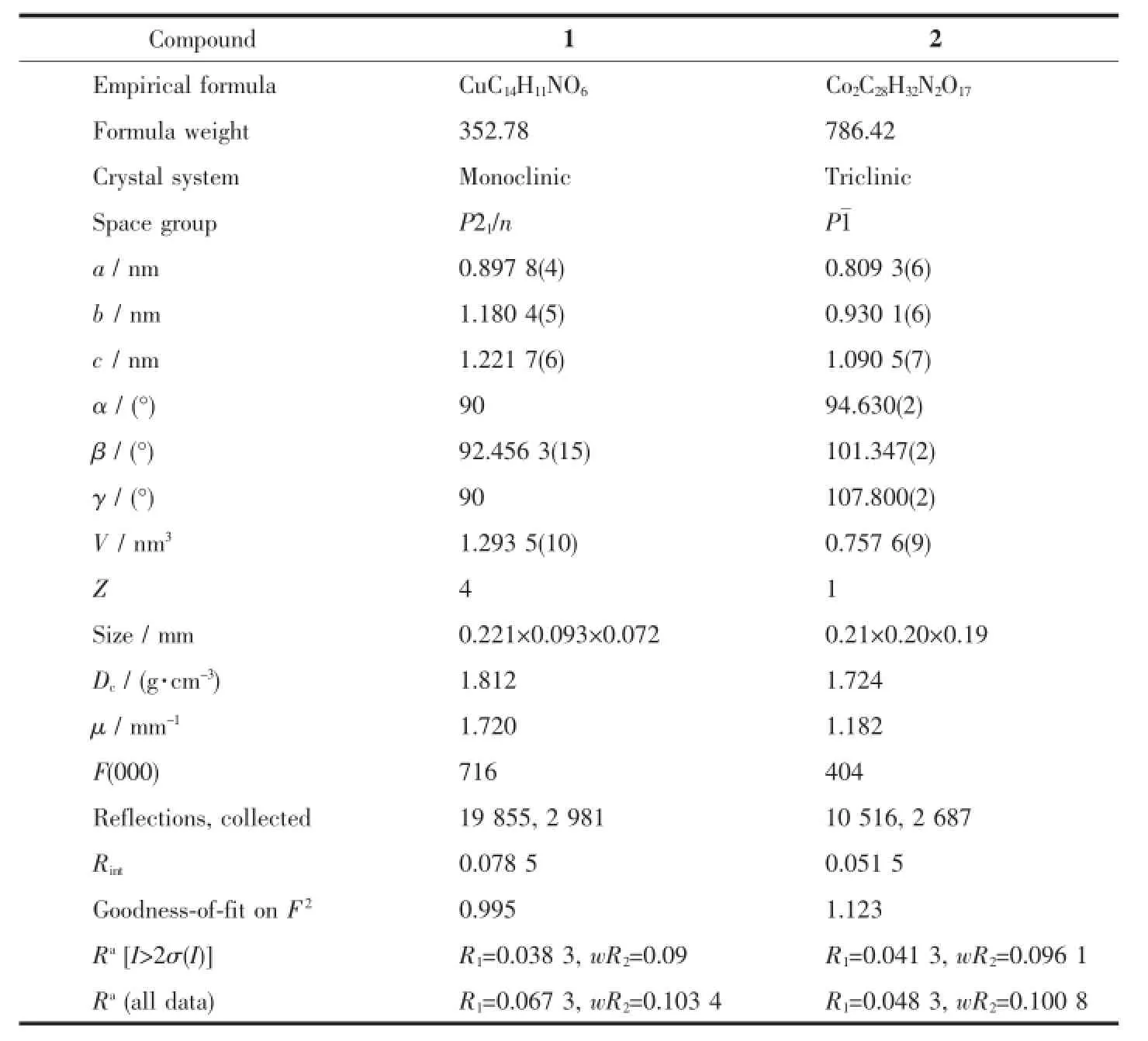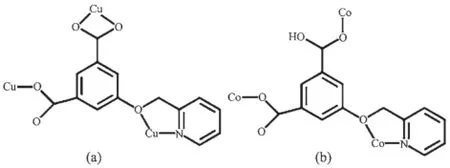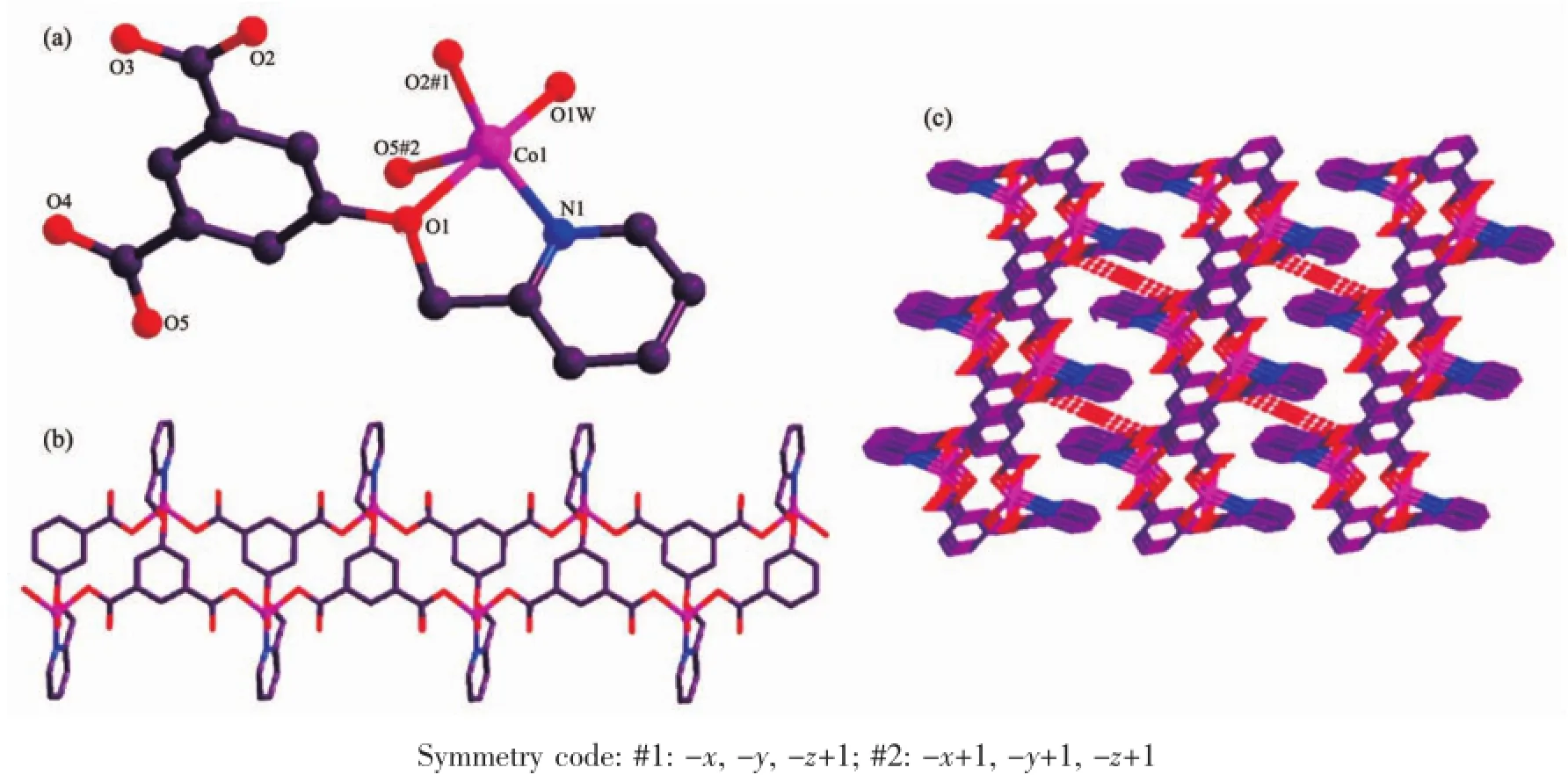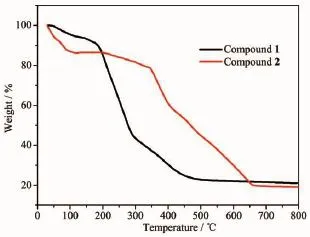基于柔性多元羧酸配体构筑的两例过渡金属配位聚合物的合成、结构及性质
2016-07-22张亚男殷海菊党蓓君陕西科技大学化学与化工学院西安710021
张亚男殷海菊 党蓓君(陕西科技大学化学与化工学院,西安 710021)
基于柔性多元羧酸配体构筑的两例过渡金属配位聚合物的合成、结构及性质
张亚男*殷海菊党蓓君
(陕西科技大学化学与化工学院,西安710021)
摘要:以柔性配体5-(吡啶-2-甲氧基)-间苯二甲酸为主配体在水热条件下合成了2例过渡金属配位聚合物 [Cu(L)·H2O]n(1),{[Co(L)·H2O]2·5H2O}n(2)(H2L=5-(吡啶-2-甲氧基)-间苯二甲酸),并通过X射线单晶衍射、红外光谱、X射线粉末衍射、元素分析和热重分析方法对其进行表征。结构分析表明:配合物1为单斜晶系P21/n空间群的二维平面结构,并呈现2-节点(3,4)-连接的拓扑网络。2为三斜晶系,P1空间群的一维链状结构,在分子间氢键的作用下构筑出三维超分子网络结构。同时对配合物1和2进行了发光性质的研究。
关键词:5-(吡啶-2-甲氧基)-间苯二甲酸;水热反应;柔性配体;荧光
Crystal engineering of metal-organic frameworks (MOFs)have attracted intense interest not only for their intriguing architectures and topologies[1],but also for their potential applications as functional materials in the field of luminescence,molecular recognition, magnetism,catalysis,gas storage and so on[2-8].In this aspect,considerable progress has been made on the theoretical prediction and network-based approaches for controlling the topology and geometries of the networks to produce useful functional materials[9-12].
国家自然科学基金青年基金(No.21401121)、陕西省科学技术研究中心发展计划项目(No.2014JQ2061)、陕西省教育厅科学研究项目计划(No.15JK1109)、陕西科技大学科研启动基金(No.BJ11-22)和西北大学教育部重点实验室开放基金(No.338080037)资助。
*通信联系人。E-mail:yanan12151215@163.comBut so far,how to reasonably design and synthesize metal-organic frameworks with anticipated structures remain a great challenge to chemists.It is quite difficult to select an appropriate organic ligand with suitable shape,functionality,flexibility,and symmetry,which helps us obtain the target products[13].Therefore,systematicresearchonthistopicisstillvery necessary for understanding the roles of the factors in the formation of metal-organic frameworks.
Pyridinecarboxylic ligand and their derivatives,exhibiting excellent coordination ability and diverse coordination modes,have been extensively employed to construct MOFs[14-17].However,only a few compounds based on the flexible pyridinecarboxylate ligands have been reported[18-23].Among them,5-(pyridin-2-ylmethoxy)-isophthalic acid as a multifunctional organic ligand,contains a flexible-CH2-O-spacer between the pyridyl and phenyl ring,which not only makes it exhibits various coordination modes in the process of self-assembly but also can adopt a suitable configuration according to the requirements of metal ions.Here we selected flexible 5-(pyridin-2-ylmethoxy)-isophthalic acid(H2L)[24]as organic ligand,to react with different transition metal ions(Cu(Ⅱ),Co(Ⅱ))under hydrothermal conditions,and successfully obtained two new coordination polymers,namely[Cu(L)·H2O]n(1)and{[Co(L)H2O]2·5H2O}n(2).All crystal structures havebeendeterminedbysingle-crystalX-ray diffraction,IR,elemental,PXRD and TGA analyses. Photoluminescence properties of two complexes have been studied.
1 Experimental
1.1Materials and physical measurements
The reagents were used directly as supplied commercially without further purification.Elemental analyses(C,H,N)were determined with a Perkin-Elmer model 240C automatic instrument.Infrared spectra on KBr pellets were recorded on a Bruker Equinox-55 spectrometer in the range of 4 000~400 cm-1.Luminescence spectra for the solid samples were investigatedwithaHitachiF-4500fluorescence spectrophotometer.TheX-raypowderdiffraction patternwasrecordedwithaPigakuD/MaxⅢdiffractometer(40 kV,40 mA),using Cu Kα radiation (λ=0.015 42 nm)with a 2θ range of 5°~50°.Therma analysis was determined with a Netzsch STA 449C microanalyzer under flowing N2atmosphere at a heating rate of 10℃·min-1.
1.2Synthesis of[Cu(L)·H2O]n(1)
Compound 1 was obtained as blue stick-shaped crystals by treatment of Cu(NO3)2with H2L under th hydrothermal system.A mixture of Cu(NO3)2·3H2O (0.05 mmol,0.012 1 g),H2L ligand(0.05 mmol,0.013 7 g),H2O(9.0 mL),and NaOH(25%,0.1 mL)solution was stirred under air atmosphere for half an hour Then the mixture was transferred to a 25 mL stainless steel reactor with Teflon liner and held at 145℃fo 72 h.The reaction system was cooled to room temper ature at a rate of 5℃·h-1.A large amount of comp ound 1 were obtained in 46%yield based on Cu(NO3)·3H2O.Anal.Calcd.for CuC14H11NO6(%):C,47.67;H 3.14;N,3.97.Found(%):C,47.58;H,3.09;N,3.96 IR(KBr,cm-1):3 201(m),2 939(w),1 616(m),1 557 (s),1 361(s),1 275(m),1 235(w),1 165(w),1 117(m)1 050(s),921(m),770(m),720(s).
1.3Synthesis of{[Co(L)H2O]2·5H2O}n(2)
After pH value of the solution was adjusted to 7 with NaOH(1 mol·L-1),the mixture of Co(NO3)2·6H2O (0.05 mmol,0.014 6 g),H2L(0.05 mmol,0.013 7 g and H2O(10 mL)were placed in a 25 mL Teflon lined stainless steel reactor under autogenous pressure at 95℃for 36 h.After the reaction system was cooled to room temperature,purple prism-shaped blocks were obtained,washed with distilled water,and dried (Yield:56%based on Co(NO3)2·6H2O).Anal.Calcd for Co2C28H32N2O17(%):C 42.76,H 4.10,N 3.56 Found(%):C 42.59,H 4.29,N 3.36.IR(KBr,cm-1)3 733(m),3 665(w),3 090(m),2 925(m),2 849(m)1 619(m),1 557(s),1 451(m),1 354(s),1 230(m),1 047 (m),770(s),716(m),614(m),456(w).
1.4Crystallographic data collection and refinement
Diffraction experiments for compound 1~2 wer carried out with Mo Kα radiation using a BRUKER SMART APEX CCD diffractometer(λ=0.071 073 nmby using φ-ω scan technique with a potential of 40 kV and a current of 40 mA fitted with a graphite monochromator in the parallel mode(175 mm collimator with 0.5 mm pinholes).All intensity data were corrected for Lorentz and polarization effects(SAINT)[25],andempiricalabsorptioncorrectionsbasedon equivalent reflections were applied(SADABS)[26].The structurewassolvedusingdirectmethodsand successive Fourier difference synthesis(SHELXS-97)[27],and refined using the full-matrix least-squares method on F2with anisotropic thermal parameters for all nonhydrogen atoms(SHELXL-97)[28].The crystal data and the structure refinement of compounds are summarized in Table 1.Selected bond lengths and angles are listed in Table 2.Possible hydrogen bond geometries of complex 2 are listed in Table 3.All of the nonhydrogen atoms were refined anisotropically.
CCDC:1430584,1;1430585,2.

Table 1 Crystal data and structure parameters for complexes 1~2

Table 2 Selected bond lengths(nm)and angles(°)for 1~2

Continued Table 2

Table 3 Hydrogen-bonding geometries for compound 2
2 Results and discussion
2.1Description of the structure of[Cu(L)·H2O]n(1)
X-ray single-crystal diffraction analysis reveals that 1 crystallizes in the monoclinic system with P21/n space group and features a 2D layered structure. Compound 1 asymmetric unit contains one crystallographically independent Cu(Ⅱ)ions,one individual L2-ligand as well as one coordinated water molecule.As shown in Fig.1a.Cu1 is six-coordinated by five oxygen and one nitrogen atom:one oxygen from coordinated water molecule and four carboxylate oxygen,one nitrogen atom from three different L ligands,displaying a distorted octahedral coordination geometry. The Cu-O distances are 0.194 3(2)~0.264 8(1)nm and the Cu-N distance is 0.199 8(2)nm,which are similar to the reported Cu-based compound[29-30].Each L links three different Cu(Ⅱ) centers in tridentate bridging mode with two carboxyl groups adopting μ2-η1∶η1∶η1-bridging coordination mode(Scheme 1a).A 2D polymeric layer of 1 is generated by the extension of cyclic motif connectivity(Fig.1b).Further,the 2D layersarrangeinanoffsetwayinthe3D supramolecular network along the b axis(Fig.1d).In order to fully understand the structure of compound 1 clearly,the topological method is used to simplify the structure.Further analysis suggests that such a subne could be described as a simple 2D 2-nodal(3,4)connected topology net with the point symbol of{4.82}in which each L2-ligands sever as the 3-connected linkers,while the Cu(Ⅱ) center acts as a 4-connected node(Fig.1c).

Scheme 1 Coordination modes of L ligand in compounds 1~2
2.2Description of the structure of{[Co(L)H2O]2· 5H2O}n(2)

Fig.1 (a)View of the coordination environments of Cu(Ⅱ)ions in 1;(b)2D polymeric layer of 1;(c)Schematic view of the 2D 2-nodal(3,4)-connected topology net with the point symbol of{4.82}in 1;(d)View of 3D supramolecular network along the b axis

Fig.2 (a)View of the coordination environments of Co(Ⅱ)ions in 2;(b)Representation of an infinite 1D distorted ladder chain;(c)View of 3D network by linkage of hydrogen bonds
The single crystallographic analysis reveals tha complex 2 crystallizes in triclinic system P1 spac group.The asymmetric unit of complex 2 is made up of one Co(Ⅱ) ion,one L ligand and one coordination water molecule.As shown in Fig.2a,the Co(Ⅱ) adopts five-coordinated by three oxygen atoms from three different L2-ligand,one coordinated water,and one pyridine nitrogen atom,displaying a distorted trigonal bipyramidal coordination geometry.The Co-O distancesare in the range of 0.199 7(2)~0.241(2)nm,and the Co-N distance is 0.205 1(2)nm,respectively.In 2,each L2-ligand with the dihedral angle of 70.82°between thepyridineandbenzeneringsconnectsthree different Co(Ⅱ) ions in a μ3-O′,O″,O‴,N coordination mode(Scheme 1b).Similar to the compound 1,there is an isolated[Co2L2]metallocyclic motif by the connection L ligands and metal atoms,which are expanded to form a 1D ladder(Fig.2b).The different structures between 1 and 2 are due to the different coordination modes of carboxyl group.Furthermore,the presence of hydrogen-bonds is essential to link the 1D network to construct a 3D polymer network(Fig 2c).The free water molecules and the-COO group o L2-ligands are responsible for hydrogen bonding.
2.3PXRD and thermal stability analyses
In order to confirm the phase purity of the bulk materials at room temperature,PXRD experiments on the bulk materials of 1~2 have been carried out(Fig.3)Because the experimental patterns match well with simulated patterns base on the crystal data,the synthesized crystals of 1~2 are regarded as the pure phases.

Fig.3 PXRD patterns of complexes 1(left)and 2(right)
To study the thermal stabilities of two complexes,thermal gravimetric analysis(TGA)of complexes 1~2 was carried out under N2atmosphere(Fig.4).As for 1,the weight loss of 5.97%(Calcd.5.11%)before 150℃reveals the exclusion of coordinated water molecule. Then the framework begins to decompose until 650℃,corresponding to the loss of L ligands.The remaining weight of 21.08%might be CuO component(Calcd 22.55%).For 2,the weight loss of 15.32% (Calcd 16.04%)in the range of 30~210℃reveals the exclusion of water molecule.The removal of organic ligands occurs from 149 to 658℃,and the remaining weigh of 19.31%might be CoO component(Calcd.19.06%).

Fig.4 TGA curves of complexes 1~2
2.4Luminescence properties
The solid-state luminescence behaviors of H2L ligand and complexes 1~2 are investigated at room temperature(Fig.5).The H2L ligand displays two emission bands at 381 and 472 nm(λex=280 nm)which can be assigned to π-π*transition fluorescence in nature.As shown in Fig.5,the fluorescent emissions are observed at 408 and 462 nm for 1,390 and 449 nm for 2 upon excitation at 280 nm,respectively.The main peaks in 1 and 2 are similar to those of free H2L which can be propably ascribed to π-π*intraligand transitions of L2-ligand according to the literature[31-32].

Fig.5 Solid-state photoluminescent spectra of free H2L,1 and 2
3 Conclusions
Based on flexible pyridinecarboxylate ligands(5-(pyridin-2-ylmethoxy)-isophthalic acid),the Cu(Ⅱ)/Co(Ⅱ)metal-organic frameworks 1~2 have been constructed successfully through hydrothermal method.Compound 1 exhibits a 2D layered structure,which possesses a 2-nodal(3,4)-connected topology.Compound 2 shows a 1D chain structure,which is connected to 3D supramolecular structure via hydrogen bonds.Complexes 1~2 display different motifs due to different coordination modes of H2L.Finally,these interesting observations prompt us to further research the rational synthetic strategy to obtain new crystalline materials with special properties and structures.
References:
[1]Cao X Y,Lin Q P,Qin Y Y,et al.Cryst.Growth Des.,2009,9 (1):20-23
[2]ZHANG La-Ying(张腊莹),XU Kang-Zhen(徐抗震),SONG Ji-Rong(宋纪蓉),et al.Chinese J.Inorg.Chem.(无机化学学报),2010,26(5):899-904
[3]Batten S R,Robson R.Angew.Chem.Int.Ed.,1998,37(11): 1460-1494
[4]Han S D,Chen Y Q,Zhao J P,et al.CrystEngComm,2014,16:753-756
[5]Horcajada P,Gref R,Baati T,et al.Chem.Rev.,2012,112: 1232-1268
[6]Wu Y,Yang G P,Zhao Y,et al.Dalton Trans.,2015,44: 3271-3277
[7]Yang G P,Hou L,Ma L F,et al.CrystEngComm,2013,15: 2561-2578
[8]Zhang Y,Ju W,Xu X,et al.CrystEngComm,2014,16:5681-5688
[9]Yaghi O M,O′Keeffe M,Ockwig N W,et al.Nature,2003,423:705-714
[10]NagarajaCM,UgaleaB,ChanthapallyA,etal.CrystEngComm,2014,14:4085-4090
[11]LI Yun-Tao(李运涛),ZHANG Ya-Nan(张亚男),HAI Xiao(海啸),et al.Chinese J.Inorg.Chem.(无机化学学报),2013,29(11):2475-2479
[12]Zhang Y N,Dang B J,Wang Y,et al.Inorg.Chem.Comm.,2015,61:89-92
[13]Ferey G,Mellot C,Serre C.Science,2005,309(5743):2040-2042
[14]ZHANG Ya-Nan(张亚男),DANG Bei-Jun(党蓓君),HAI Xiao(海啸),et al.Chinese J.Inorg.Chem.(无机化学学报),2014,30(8):1931-1937
[15]Sun J Y,Weng L H,Zhou Y M,et al.Angew.Chem.Int. Ed.,2002,41:4471-4476
[16]Wei Y L,Hou H W,Li L K,et al.Cryst.Growth Des.,2005,5:1405-1412
[17]Lin X,Blake A J,Wilson C,et al.J.Am.Chem.Soc.,2006,128:10745-10751
[18]Shekhah O,Liu J,Fischer R A,et al.Chen.Soc.Rev.,2011,40(2):1081-1106
[19]Ren P,Liu M L,Zhang J,et al.Dalton Trans.,2008,35: 4711-4713
[20]Zhang X,Cheng J K,Chen F,et al.Inorg.Chem.Comm.,2011,14:358-361
[21]Meng Q H.Inorg.Chem.Comm.,2014,49:82-85
[22]Xing G E,Zhang Y,Zhang S F,et al.J.Coord.Chem.,2015,68:2006-2013
[23]Zhang X,Cheng J K,Yin P X,et al.J.Mol.Struct.,2011,990:1-5
[24]Jack M H,Saeed M,Ali A S.Inorg.Chem.,2004,43:1810-1812
[25]Sheldrick G M.SADABS,Program for Empirical Absorption Correction of Area Detector Data,University of Göttingen,Germany,1997.
[26]APEXⅡSoftware Version 6.3.1,Bruker AXS Inc.,Madison,WI,2004.
[27]Sheldrick G M.SHELXS-97,Program for X-ray Crystal Structure Solution,University of Göttingen,Germany,1997.
[28]Sheldrick G M.SHELXL-97,Program for X-ray Crystal Structure Refinement,University of Göttingen,Germany,1997.
[29]Zheng B H,Ming Y Z,Yuan D Q,et al.CrystEngComm,2011,13:6945-6949
[30]Guo X G,Yang W B,Wu X Y,et al.CrystEngComm,2013,15:3654-3663
[31]Chu Q,Liu G X,Huang Y Q,et al.Dalton Trans.,2007,38: 4302-4311
[32]Zhang Y N,Wang Y Y,Hou L,et al.CrystEngComm,2010,1:1-13
中图分类号:O614.121;O614.81+2
文献标识码:A
文章编号:1001-4861(2016)05-0846-07
DOI:10.11862/CJIC.2016.119
收稿日期:2015-10-28。收修改稿日期:2016-04-06。
Two Transition Metal Coordination Complexes Based on a Flexible Pyridinecarboxylate Ligand:Syntheses,Structures,and Properties
ZHANG Ya-Nan*YIN Hai-JuDANG Bei-Jun
(College of Chemistry&Chemical Engineering,Shaanxi University of Science&Techology,Xi′an 710021,China)
Abstract:Two transition metal coordination complexes[Cu(L)·H2O]n(1),{[Co(L)H2O]2·5H2O}n(2)(H2L=5-(pyridin -2-ylmethoxy)-isophthalic acid)were synthesized through hydrothermal method.They were characterized by single-crystal,IR,PXRD,elemental and TGA analyses.Structural analysis indicated that the complexes 1 and 2 were linked into infinite structures bridged by organic acid ligands.1 crystallizes in the monoclinic system with P21/n space group and features a 2D layered structure,which possesses a 2-nodal(3,4)-connected topology;2 crystallizes in triclinic system P1 space group with a 1D structure and further are connected to 3D supramolecular structure via hydrogen bonds.Moreover,compounds 1~2 exhibited photoluminescence in the solid state at room temperature.CCDC:1430584,1;1430585,2.
Keywords:5-(pyridin-2-ylmethoxy)-isophthalic acid;hydrothermal reaction;flexible ligand;fluorescence
